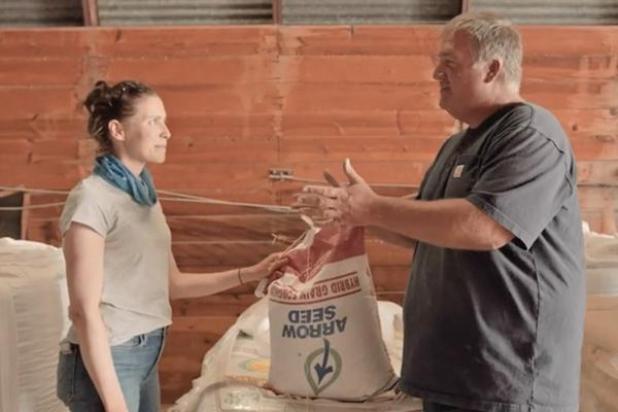
Steve Tucker, at right, shows Kristy Lewis of Quinn Snacks large bags of white sorghum he produced using regenerative farming methods.
Tucker reaps benefits of regenerative farming
For the past 10 or so years, local farmer Steve Tucker has been focused on practicing regenerative agriculture, which aims to improve soil health and make farming better for the future.
Tucker has been farming for around 30 years. After learning about the importance of regenerative farming through conferences and food shows, he realized he had changes to make at his farm.
“A few years ago, the big term was sustainable agriculture, and that gets down to sustaining a resource that we already have,” Tucker explained. “If we regenerate it, that means we try and make it better than what it was, so it’s better for the future.”
Tucker defines regenerative agriculture as “trying to make things better tomorrow than what they are today.”
One of the most important foundations for regenerative farming is soil health.
Tucker aims to follow soil health principles as laid out by the Natural Resources Conservation Service. These principles are soil armor, minimizing soil disturbance, plant diversity, continual live plant or root and livestock integration.
According to Jay Fuhrer, NRCS Soil Health Specialist, soil armor helps control wind and water erosion, evaporation rates and soil temperatures. It also prevents compaction from rainfall on bare soil, as well as surpresses weed growth. Finally, it provides a protective habitat for the soil’s surface dwellers.
Soil disturbances can come in several forms: biological (such as overgrazing), chemical (such as over-application of nutrients and pesticides) and physical (such as tillage).
No-till farming is one of the ways Tucker started his involvement in regenerative farming.
“No-tilling was big because it was efficient and freed up a lot more time,” he said. “It also helped preserve soil moisture, which is very critical in our neck of the woods. I started realizing that it’s not about how much rain we get, it’s about how much rain we get into the soil.”
Plant diversity is important, according to Fuhrer, because it takes the lancscape back to its roots, where there was abundant plant diversity working together as a community to “provide forage for large herbivore populations.”
Diverse crop rotations provide biodiversity, and can be designed to include crops of many varieties, such as high water users, low water users, tap root, fibrous root, etc.
Read the full article in our FREE Salute to Grain section. Click here!
